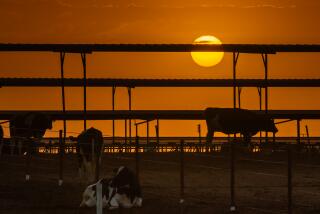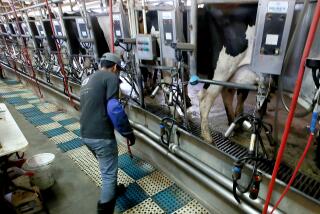Alabama Animal Tests Positive for Mad Cow
- Share via
The U.S. Department of Agriculture said Monday that a cow from an Alabama dairy farm had tested positive for mad cow disease, the third U.S. case of the bovine brain-wasting syndrome.
The stricken animal was tested for bovine spongiform encephalopathy, or BSE, because it was a “downer,” an animal that couldn’t walk. The cow posed no risk to public health because it wasn’t sent to a food processing plant, officials said.
“A local private veterinarian euthanized and sampled the animal and sent the samples for further testing,” said John Clifford, the department’s chief veterinarian. “The animal was buried on the farm and it did not enter the animal or human food chains.”
Eating beef contaminated with BSE can cause a form of the disease in people called variant Creutzfeldt-Jakob, but Clifford and public health advocates said there was little cause for alarm.
“It is far more likely that you will die from a heart attack caused by eating a lot of beef than you would from BSE,” said Caroline Smith DeWaal, director of food safety for the Center for Science in the Public Interest, a consumer interest group.
In December 2003, a diary cow imported from Canada became the first U.S. case of mad cow. The Alabama cow was the second U.S.-born animal found to have the disease in testing 650,000 animals from high-risk populations since June 2004.
In this instance, the infected animal was a cow used to produce calves for the beef industry, the USDA said. It had lived on the Alabama farm for a year, and judging from its teeth was probably at least 10 years old.
Clifford said the agency was investigating the cow’s history and working to locate animals born in the same herd within one year of its birth. The agency also is looking for the cow’s offspring, although there is no evidence that the disease can be passed through gestation, said Dean Cliver, a UC Davis professor of food safety.
The exact age of the animal is important. All three cases of BSE discovered in the United States have been in animals born prior to a 1997 Food and Drug Administration regulation that banned feeding cattle the remains of cows, sheep and other ruminants. BSE is spread when cows eat brain or nerve parts from an infected animal. It might also occur spontaneously in a small percentage of older animals, Cliver said.
DeWaal said the sketchy details released about this latest incident highlight flaws in the USDA system for quickly assessing the situation in a case of mad cow disease.
“The USDA should be able to tell us right away the age of the animal, its origin and in this case how many offspring it has given birth to,” DeWaal said.
In response to animal disease outbreaks, other countries have developed mandatory animal tracking systems, often using technology from American companies, she said. The USDA has a 2009 target date for implementation of such a system, but DeWaal is skeptical that it will be in place by that time.
First diagnosed in Britain in 1986, BSE infected 178,000 British cattle; 3.7 million animals were eventually destroyed. About 150 cases have been reported worldwide of the human variant of the fatal brain-wasting disease.
More to Read
Sign up for Essential California
The most important California stories and recommendations in your inbox every morning.
You may occasionally receive promotional content from the Los Angeles Times.














